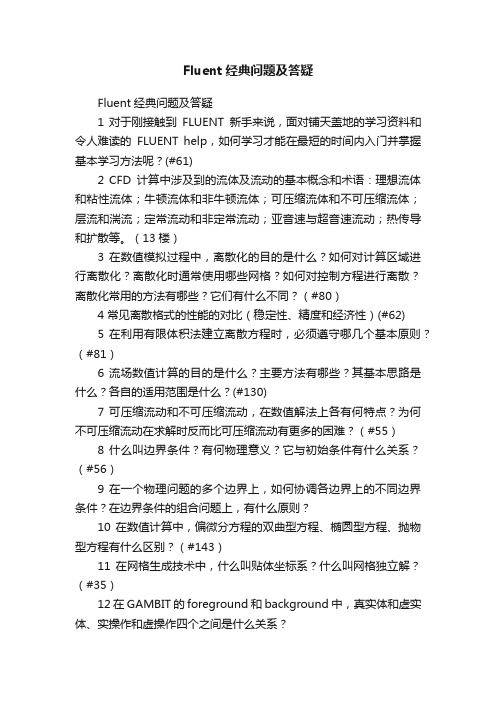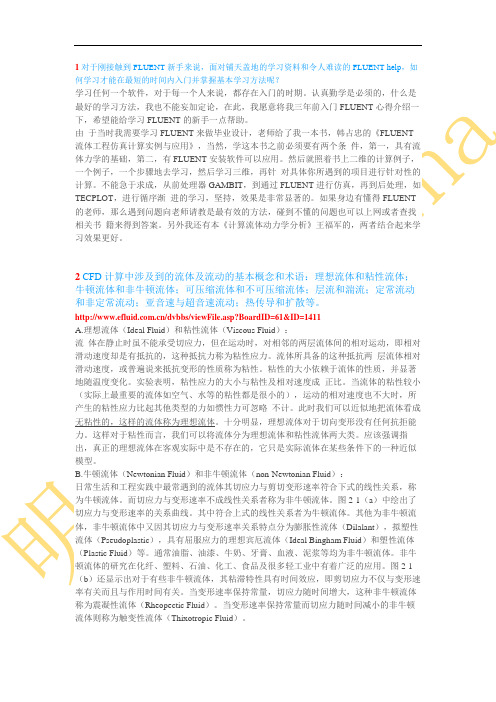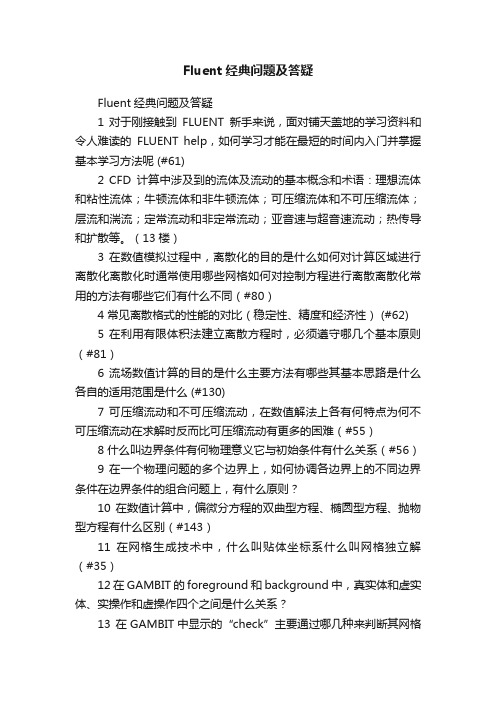FLUENT常见问题
Fluent动网格的经典21个问题

Fluent动网格的经典21个问题弹簧近似光滑模型(spring-based smoothing)、动态分层模型(dynamiclayering)和局部重划模型(local remeshing)。
6.在Fluent中,弹簧近似光滑模型的使用范围是什么?原则上弹簧光顺模型可以用于任何一种网格体系,但是在非四面体网格区域(二维非三角形),最好在满足下列条件时使用弹簧光顺方法:(1)移动为单方向。
(2)移动方向垂直于边界。
如果两个条件不满足,可能使网格畸变率增大。
另外,在系统缺省设置中,只有四面体网格(三维)和三角形网格(二维)可以使用弹簧光顺法,如果想在其他网格类型中激活该模型,需要在dynamic-mesh-menu下使用文字命令spring-on-all-shapes?,然后激活该选项即可。
7.在Fluent中,动态分层模型的应用有什么限制?(1)与运动边界相邻的网格必须为楔形或者六面体(二维四边形)网格。
(2)在滑动网格交界面以外的区域,网格必须被单面网格区域包围。
(3)如果网格周围区域中有双侧壁面区域,则必须首先将壁面和阴影区分割开,再用滑动交界面将二者耦合起来。
(4)如果动态网格附近包含周期性区域,则只能用FLUENT的串行版求解,但是如果周期性区域被设置为周期性非正则交界面,则可以用FLUENT的并行版求解。
8.在Fluent中,应用局部网格重划模型应注意什么事项?局部网格重划模型仅能用于四面体网格和三角形网格。
在定义了动边界面以后,如果在动边界面附近同时定义了局部重划模型,则动边界上的表面网格必须满足下列条件:(1)需要进行局部调整的表面网格是三角形(三维)或直线(二维)。
(2)将被重新划分的面网格单元必须紧邻动网格节点。
(3)表面网格单元必须处于同一个面上并构成一个循环。
(4)被调整单元不能是对称面(线)或正则周期性边界的一部分。
9.在Fluent中,动网格更新方法应该根据什么来选择?通常来讲,在一个case中,我们使用的更新方法都是根据网格类型以及和要实现的运动来选择的,很多时候都是几种更新方法搭配起来使用的。
Fluent经典问题及答疑

Fluent经典问题及答疑Fluent经典问题及答疑1 对于刚接触到FLUENT新手来说,面对铺天盖地的学习资料和令人难读的FLUENT help,如何学习才能在最短的时间内入门并掌握基本学习方法呢?(#61)2 CFD计算中涉及到的流体及流动的基本概念和术语:理想流体和粘性流体;牛顿流体和非牛顿流体;可压缩流体和不可压缩流体;层流和湍流;定常流动和非定常流动;亚音速与超音速流动;热传导和扩散等。
(13楼)3 在数值模拟过程中,离散化的目的是什么?如何对计算区域进行离散化?离散化时通常使用哪些网格?如何对控制方程进行离散?离散化常用的方法有哪些?它们有什么不同?(#80)4 常见离散格式的性能的对比(稳定性、精度和经济性)(#62)5 在利用有限体积法建立离散方程时,必须遵守哪几个基本原则?(#81)6 流场数值计算的目的是什么?主要方法有哪些?其基本思路是什么?各自的适用范围是什么?(#130)7 可压缩流动和不可压缩流动,在数值解法上各有何特点?为何不可压缩流动在求解时反而比可压缩流动有更多的困难?(#55)8 什么叫边界条件?有何物理意义?它与初始条件有什么关系?(#56)9 在一个物理问题的多个边界上,如何协调各边界上的不同边界条件?在边界条件的组合问题上,有什么原则?10 在数值计算中,偏微分方程的双曲型方程、椭圆型方程、抛物型方程有什么区别?(#143)11 在网格生成技术中,什么叫贴体坐标系?什么叫网格独立解?(#35)12 在GAMBIT的foreground和background中,真实体和虚实体、实操作和虚操作四个之间是什么关系?13 在GAMBIT中显示的“check”主要通过哪几种来判断其网格的质量?及其在做网格时大致注意到哪些细节?(#38)14 画网格时,网格类型和网格方法如何配合使用?各种方法有什么样的应用范围及做网格时需注意的问题?(#169)15 对于自己的模型,大多数人有这样的想法:我的模型如何来画网格?用什么样的方法最简单?这样做网格到底对不对?(#154)16 在两个面的交界线上如果出现网格间距不同的情况时,即两块网格不连续时,怎么样克服这种情况呢?(#40)17 依据实体在GAMBIT建模之前简化时,必须遵循哪几个原则?(#170)18 在设置GAMBIT边界层类型时需要注意的几个问题:a、没有定义的边界线如何处理?b、计算域内的内部边界如何处理(2D)?(#128)19 为何在划分网格后,还要指定边界类型和区域类型?常用的边界类型和区域类型有哪些?(#127)20 何为流体区域(fluid zone)和固体区域(solid zone)?为什么要使用区域的概念?FLUENT 是怎样使用区域的?(#41)21 如何监视FLUENT的计算结果?如何判断计算是否收敛?在FLUENT中收敛准则是如何定义的?分析计算收敛性的各控制参数,并说明如何选择和设置这些参数?解决不收敛问题通常的几个解决方法是什么?(9楼)22 什么叫松弛因子?松弛因子对计算结果有什么样的影响?它对计算的收敛情况又有什么样的影响?(7楼)23 在FLUENT运行过程中,经常会出现“turbulence viscous rate”超过了极限值,此时如何解决?而这里的极限值指的是什么值?修正后它对计算结果有何影响?(#28)24 在FLUENT运行计算时,为什么有时候总是出现“reversed flow”?其具体意义是什么?有没有办法避免?如果一直这样显示,它对最终的计算结果有什么样的影响?(#29)25 燃烧过程中经常遇到一个“头疼”问题是计算后温度场没什么变化?即点火问题,解决计算过程中点火的方法有哪些?什么原因引起点火困难的问题? (#183)26 什么叫问题的初始化?在FLUENT中初始化的方法对计算结果有什么样的影响?初始化中的“patch”怎么理解?(12楼)27 什么叫PDF方法?FLUENT中模拟煤粉燃烧的方法有哪些?(#197)28 在利用prePDF计算时出现不稳定性如何解决?即平衡计算失败。
FLUENT常见问题

FLUENT常见问题湍流与黏性有什么关系?湍流和粘性都是客观存在的流动性质。
湍流的形成需要⼀定的条件,粘性是⼀切流动都具有的。
流体流动⽅程本⾝就是具⾮线性的。
NS⽅程中的粘性项就是⾮线性项,当然⽆粘的欧拉⽅程也是⾮线性的。
粘性是分⼦⽆规则运动引起的,湍流相对于层流的特性是由涡体混掺运动引起的。
湍流粘性是基于湍流体的parcel湍流混掺是类⽐于层流体中的分⼦⽆规则运动,只是分⼦⽆规则运动遥远弱些吧了。
不过,这只是类⽐于,要注意他们可是具有不同的属性。
粘性是耗散的根源,实际流体总是有耗散的。
⽽粘性是制约湍流的。
LANDAU说,粘性的存在制约了湍流的⾃由度。
湍流粘性系数和层流的是不⼀样的,层流的粘性系数基本可认为是常数,可湍流中层流底层中粘性系数很⼩,远⼩于层流时的粘性系数;⽽在过渡区,与之相当,在⼀个数量级;在充分发展的湍流区,⼜远⼤于层流时的粘性系数.这是鮑⾟内斯克1987年提出的。
1 FLUENT的初始化⾯板中有⼀项是设置从哪个地⽅开始计算(compute from),选择从不同的边界开始计算有很⼤的区别吗?该怎样根据具体问题选择从哪⾥计算呢?⽐如有两个速度⼊⼝A和B,还有压⼒出⼝等等,是选速度⼊⼝还是压⼒出⼝?如果选速度⼊⼝,有两个,该选哪个呀?有没有什么原则标准之类的东西?⼀般是选取ALL ZONE,即所有区域的平均处理,通常也可选择有代表性的进⼝(如多个进⼝时)进⾏初始化。
对于⼀般流动问题,初始值的设定并不重要,因为计算容易收敛。
但当⼏何条件复杂,⽽且流动速度⾼变化快(如⾳速流动),初始条件要仔细选择。
如果不收敛,还应试验不同的初始条件,甚⾄逐次改变边界条件最后达到所要求的条件。
2 要判断⾃⼰模拟的结果是否是正确的,似乎解的收敛性要⽐那些初始条件和边界条件更重要,可以这样理解吗?也就是说,对于⼀个具体的问题,初始条件和边界条件的设定并不是唯⼀的,为了使解收敛,需要不断调整初始条件和边界条件直到解收敛为⽌,是吗?如果解收敛了,是不是就可以基本确定模拟的结果是正确的呢?对于⼀个具体的问题,边界条件的设定当然是唯⼀的,只不过初始化时可以选择不同的初始条件(指定常流),为了使解的收敛⽐较好,我⼀般是逐渐的调节边界条件到额定值("额定值"是指你题⽬中要求的⼊⼝或出⼝条件,例如计算⼀个管内流动,要求⼊⼝压⼒和温度为10MPa和3000K,那么我开始叠代时选择⼊⼝压⼒和温度为1MPa和500K(假设,这看你⾃⼰问题了),等流场计算的初具规模、收敛的较好了,再逐渐调⾼压⼒和温度,经过好⼏次调节后最终到达额定值10MPa和3000K,这样⽐⼀开始就设为10MPa 和3000K收敛的要好些)这样每次叠代可以⽐较容易收敛,每次调节后不⽤再初始化即⾃动调⽤上次的解为这次的初始解,然后继续叠代。
Fluent经典问题及答疑

Fluent经典问题及答疑1 对于刚接触到FLUENT新手来说,面对铺天盖地的学习资料和令人难读的FLUENT help,如何学习才能在最短的时间内入门并掌握基本学习方法呢 (#61)2 CFD计算中涉及到的流体及流动的基本概念和术语:理想流体和粘性流体;牛顿流体和非牛顿流体;可压缩流体和不可压缩流体;层流和湍流;定常流动和非定常流动;亚音速与超音速流动;热传导和扩散等。
(13楼)3 在数值模拟过程中,离散化的目的是什么如何对计算区域进行离散化离散化时通常使用哪些网格如何对控制方程进行离散离散化常用的方法有哪些它们有什么不同(#80)4 常见离散格式的性能的对比(稳定性、精度和经济性) (#62)5 在利用有限体积法建立离散方程时,必须遵守哪几个基本原则(#81)6 流场数值计算的目的是什么主要方法有哪些其基本思路是什么各自的适用范围是什么 (#130)7 可压缩流动和不可压缩流动,在数值解法上各有何特点为何不可压缩流动在求解时反而比可压缩流动有更多的困难(#55)8 什么叫边界条件有何物理意义它与初始条件有什么关系(#56)9 在一个物理问题的多个边界上,如何协调各边界上的不同边界条件在边界条件的组合问题上,有什么原则?10 在数值计算中,偏微分方程的双曲型方程、椭圆型方程、抛物型方程有什么区别(#143)11 在网格生成技术中,什么叫贴体坐标系什么叫网格独立解(#35)12 在GAMBIT的foreground和background中,真实体和虚实体、实操作和虚操作四个之间是什么关系?13 在GAMBIT中显示的“check”主要通过哪几种来判断其网格的质量及其在做网格时大致注意到哪些细节(#38)14 画网格时,网格类型和网格方法如何配合使用各种方法有什么样的应用范围及做网格时需注意的问题 (#169)15 对于自己的模型,大多数人有这样的想法:我的模型如何来画网格用什么样的方法最简单这样做网格到底对不对 (#154)16 在两个面的交界线上如果出现网格间距不同的情况时,即两块网格不连续时,怎么样克服这种情况呢(#40)17 依据实体在GAMBIT建模之前简化时,必须遵循哪几个原则(#170)18 在设置GAMBIT边界层类型时需要注意的几个问题:a、没有定义的边界线如何处理b、计算域内的内部边界如何处理(2D)(#128)19 为何在划分网格后,还要指定边界类型和区域类型常用的边界类型和区域类型有哪些(#127)20 何为流体区域(fluid zone)和固体区域(solid zone)为什么要使用区域的概念FLUENT是怎样使用区域的 (#41)21 如何监视FLUENT的计算结果如何判断计算是否收敛在FLUENT中收敛准则是如何定义的分析计算收敛性的各控制参数,并说明如何选择和设置这些参数解决不收敛问题通常的几个解决方法是什么(9楼)22 什么叫松弛因子松弛因子对计算结果有什么样的影响它对计算的收敛情况又有什么样的影响(7楼)23 在FLUENT运行过程中,经常会出现“turbulence viscous rate”超过了极限值,此时如何解决而这里的极限值指的是什么值修正后它对计算结果有何影响 (#28)24 在FLUENT运行计算时,为什么有时候总是出现“reversed flow”其具体意义是什么有没有办法避免如果一直这样显示,它对最终的计算结果有什么样的影响 (#29)25 燃烧过程中经常遇到一个“头疼”问题是计算后温度场没什么变化即点火问题,解决计算过程中点火的方法有哪些什么原因引起点火困难的问题 (#183)26 什么叫问题的初始化在FLUENT中初始化的方法对计算结果有什么样的影响初始化中的“patch”怎么理解 (12楼)27 什么叫PDF方法FLUENT中模拟煤粉燃烧的方法有哪些(#197)28 在利用prePDF计算时出现不稳定性如何解决即平衡计算失败。
FLUENT相关问题汇总

FLUENT相关问题汇总1•保证网格足够精细•可能你的边界条件过于恶劣,可以尝试先把边界条件改得比较常规,待计算收敛后逐步加大边界变量值,直到符合要求•适当调小松弛因子,并选择最符合你所使用的模型的求解策略2首先应该明确两个概念:•总压=静压+动压(对不可压缩流动)•绝对压力=表压(gauge pressure)+参考压力(operating pressure)Fluent的压力边界中设定的都是表压,在pressure-inlet中设定的是总压;在pressure-outlet中设定的是静压(注意:这里面没有包含水头压力Hydrostatic Head)。
3流体在静止时虽不能承受切应力,但在运动时,对相邻的两层流体间的相对运动,即相对滑动速度却是有抵抗的,这种抵抗力称为粘性应力。
流体所具备的这种抵抗两层流体相对滑动速度,或普遍说来抵抗变形的性质称为粘性。
粘性的大小依赖于流体的性质,并显著地随溫度变化。
实验表明,粘性应力的大小与粘性及相对速度成正比。
当流体的粘性较小(实际上最重要的流体如空气、水等的粘性都是很小的),运动的相对速度也不大时,所产生的粘性应力比起其他类型的力如惯性力可忽咯小计。
此时我们可以近似地把流体看成无粘性的, 这样的流体称为理想流体。
十分明显,埋想流体对于切向变形没有任何抗拒能力。
这样对于粘性而言,我们可以将流体分为理想流体和粘性流体两大类。
应该强调指出,真正的理想流体在客观实际中是不存在的,它只是实际流体在某些条件下的一种近似模型。
4日常生活和工程实践中最常遇到的流体其切应力与剪切变形速率符合线性关系,称为牛顿流体。
而切应力与变形速率不成线性关系者称为非牛顿流体。
非牛顿流体中又因其切应力与变形速率关系特点分为膨胀性流体,拟塑性流体,具有屈服应力的理想宾厄流体和塑性流体等。
通常油脂、油漆、牛奶、牙音、血液、泥浆等均为非牛顿流体。
非牛顿流体的研究在化纤、塑料、石油、化工、食品及很多轻工业中有着广泛的应用。
Fluent 常见问题

1 现在用FLUENT的UDF来加入模块,但是用compiled udf时,共享库老是连不上?解决办法:1〉你的计算机必须安装C语言编译器。
2〉请你按照以下结构构建文件夹和存放文件:libudf/src/*.c (*.c为你的源程序);libudf/ntx86/2d(二维为2d,三维为3d)/makefile(由makefile_nt.udf改过来的)libudf/ntx86/2d(二维为2d,三维为3d)/user_nt.udf(对文件中的SOURCE,VERSION,P ARALLEL_NODE进行相应地编辑)3〉通过命令提示符进入文件夹libudf/ntx86/2d/中,运行C语言命令nmake,如果C预言编译器按装正确和你的源程序无错误,那么此时会编译出Fluent需要的库文件(*.lib)这时再启动Fluent就不会出错了。
2 在使用UDF中用编译连接,按照帮助文件中给出的步骤去做了,结果在连接中报错“系统找不到指定文件”。
udf 文件可能不在工作目录中,应该把它拷到工作目录下,或者输入它的全部路径.3 这个1e-3或者1e-4的收敛标准是相对而言的。
在FLUENT中残差是以开始5步的平均值为基准进行比较的。
如果你的初值取得好,你的迭代会很快收敛,但是你的残差却依然很高;但是当你改变初场到比较不同的值时,你的残差开始会很大,但随后却可以很快降低到很低的水平,让你看起来心情很好。
其实两种情况下流场是基本相同的。
由此来看,判断是否收敛并不是严格根据残差的走向而定的。
可以选定流场中具有特征意义的点,监测其速度,压力,温度等的变化情况。
如果变化很小,符合你的要求,即可认为是收敛了。
一般来说,压力的收敛相对比较慢一些的。
是否收敛不能简单看残差图,还有许多其他的重要标准,比如进出口流量差、压力系数波动等等尽管残差仍然维持在较高数值,但凭其他监测也可判断是否收敛。
最重要的就是是否符合物理事实或试验结论。
fluent中常见问题

1 对于刚接触到FLUENT新手来说,面对铺天盖地的学习资料和令人难读的FLUENT help,如何学习才能在最短的时间内入门并掌握基本学习方法呢?学习任何一个软件,对于每一个人来说,都存在入门的时期。
认真勤学是必须的,什么是最好的学习方法,我也不能妄加定论,在此,我愿意将我三年前入门FLUENT心得介绍一下,希望能给学习FLUENT的新手一点帮助。
由于当时我需要学习FLUENT来做毕业设计,老师给了我一本书,韩占忠的《FLUENT 流体工程仿真计算实例与应用》,当然,学这本书之前必须要有两个条件,第一,具有流体力学的基础,第二,有FLUENT安装软件可以应用。
然后就照着书上二维的计算例子,一个例子,一个步骤地去学习,然后学习三维,再针对具体你所遇到的项目进行针对性的计算。
不能急于求成,从前处理器GAMBIT,到通过FLUENT进行仿真,再到后处理,如TECPLOT,进行循序渐进的学习,坚持,效果是非常显著的。
如果身边有懂得FLUENT 的老师,那么遇到问题向老师请教是最有效的方法,碰到不懂的问题也可以上网或者查找相关书籍来得到答案。
另外我还有本《计算流体动力学分析》王福军的,两者结合起来学习效果更好。
2 CFD计算中涉及到的流体及流动的基本概念和术语:理想流体和粘性流体;牛顿流体和非牛顿流体;可压缩流体和不可压缩流体;层流和湍流;定常流动和非定常流动;亚音速与超音速流动;热传导和扩散等。
/dvbbs/viewFile.asp?BoardID=61&ID=1411A.理想流体(Ideal Fluid)和粘性流体(Viscous Fluid):流体在静止时虽不能承受切应力,但在运动时,对相邻的两层流体间的相对运动,即相对滑动速度却是有抵抗的,这种抵抗力称为粘性应力。
流体所具备的这种抵抗两层流体相对滑动速度,或普遍说来抵抗变形的性质称为粘性。
粘性的大小依赖于流体的性质,并显著地随温度变化。
实验表明,粘性应力的大小与粘性及相对速度成正比。
Fluent经典问题及答疑

Fluent经典问题及答疑Fluent经典问题及答疑1 对于刚接触到FLUENT新手来说,面对铺天盖地的学习资料和令人难读的FLUENT help,如何学习才能在最短的时间内入门并掌握基本学习方法呢 (#61)2 CFD计算中涉及到的流体及流动的基本概念和术语:理想流体和粘性流体;牛顿流体和非牛顿流体;可压缩流体和不可压缩流体;层流和湍流;定常流动和非定常流动;亚音速与超音速流动;热传导和扩散等。
(13楼)3 在数值模拟过程中,离散化的目的是什么如何对计算区域进行离散化离散化时通常使用哪些网格如何对控制方程进行离散离散化常用的方法有哪些它们有什么不同(#80)4 常见离散格式的性能的对比(稳定性、精度和经济性) (#62)5 在利用有限体积法建立离散方程时,必须遵守哪几个基本原则(#81)6 流场数值计算的目的是什么主要方法有哪些其基本思路是什么各自的适用范围是什么 (#130)7 可压缩流动和不可压缩流动,在数值解法上各有何特点为何不可压缩流动在求解时反而比可压缩流动有更多的困难(#55)8 什么叫边界条件有何物理意义它与初始条件有什么关系(#56)9 在一个物理问题的多个边界上,如何协调各边界上的不同边界条件在边界条件的组合问题上,有什么原则?10 在数值计算中,偏微分方程的双曲型方程、椭圆型方程、抛物型方程有什么区别(#143)11 在网格生成技术中,什么叫贴体坐标系什么叫网格独立解(#35)12 在GAMBIT的foreground和background中,真实体和虚实体、实操作和虚操作四个之间是什么关系?13 在GAMBIT中显示的“check”主要通过哪几种来判断其网格的质量及其在做网格时大致注意到哪些细节(#38)14 画网格时,网格类型和网格方法如何配合使用各种方法有什么样的应用范围及做网格时需注意的问题 (#169)15 对于自己的模型,大多数人有这样的想法:我的模型如何来画网格用什么样的方法最简单这样做网格到底对不对 (#154)16 在两个面的交界线上如果出现网格间距不同的情况时,即两块网格不连续时,怎么样克服这种情况呢(#40)17 依据实体在GAMBIT建模之前简化时,必须遵循哪几个原则(#170)18 在设置GAMBIT边界层类型时需要注意的几个问题:a、没有定义的边界线如何处理b、计算域内的内部边界如何处理(2D)(#128)19 为何在划分网格后,还要指定边界类型和区域类型常用的边界类型和区域类型有哪些(#127)20 何为流体区域(fluid zone)和固体区域(solid zone)为什么要使用区域的概念FLUENT是怎样使用区域的 (#41)21 如何监视FLUENT的计算结果如何判断计算是否收敛在FLUENT中收敛准则是如何定义的分析计算收敛性的各控制参数,并说明如何选择和设置这些参数解决不收敛问题通常的几个解决方法是什么(9楼)22 什么叫松弛因子松弛因子对计算结果有什么样的影响它对计算的收敛情况又有什么样的影响(7楼)23 在FLUENT运行过程中,经常会出现“turbulence viscous rate”超过了极限值,此时如何解决而这里的极限值指的是什么值修正后它对计算结果有何影响 (#28)24 在FLUENT运行计算时,为什么有时候总是出现“reversed flow”其具体意义是什么有没有办法避免如果一直这样显示,它对最终的计算结果有什么样的影响 (#29)25 燃烧过程中经常遇到一个“头疼”问题是计算后温度场没什么变化即点火问题,解决计算过程中点火的方法有哪些什么原因引起点火困难的问题 (#183)26 什么叫问题的初始化在FLUENT中初始化的方法对计算结果有什么样的影响初始化中的“patch”怎么理解 (12楼)27 什么叫PDF方法FLUENT中模拟煤粉燃烧的方法有哪些(#197)28 在利用prePDF计算时出现不稳定性如何解决即平衡计算失败。
- 1、下载文档前请自行甄别文档内容的完整性,平台不提供额外的编辑、内容补充、找答案等附加服务。
- 2、"仅部分预览"的文档,不可在线预览部分如存在完整性等问题,可反馈申请退款(可完整预览的文档不适用该条件!)。
- 3、如文档侵犯您的权益,请联系客服反馈,我们会尽快为您处理(人工客服工作时间:9:00-18:30)。
如何区分层流和紊流?以什么为标准来区分呢?从层流过渡到紊流的标准是什么?答:自然界中的流体流动状态主要有两种形式,即层流laminar和湍流(就是问题中所说的紊流)turbulence.层流是指流体在流动过程中两层之间没有相互混渗,而湍流是指流体不是处于分层流动状态。
对于圆管内流动,雷诺数小于等于2300,管流一定为层流,雷诺数大于等于8000到12000之间,管流一定为湍流,雷诺数大于2300而小于8 000时,流动处于层流与湍流的过渡区。
对于一般流动,在计算雷诺数时,可以用水力半径代替管径。
第40题:在处理高速空气动力学问题时,采用哪种耦合求解器效果更好?为什么?高速空气动力学问题也属于可压缩流动的范围,在Fluent中原则上,使用Pressure-ba sed和Density-based求解器都可以。
从历史根源上讲,基于压力的求解器以前主要用于不可压缩流动和微可压缩流动,而基于密度的求解器用于高速可压缩流动。
现在,两种求解器都适用于从不可压到高速可压的很大范围流动,但总的来讲,当计算高速可压缩流动时,基于密度的求解器还是璧基于压力的求解器更有优势,因此,在使用Fluent计算高速可压缩流动时,推荐使用Density-based求解器。
也许有很多人对于Pressure-based和Density-based求解器的原理的认识还不够深,在此稍微介绍一下:求解Navier-Stokes方程的计算方法根据连续方程的处理方式,可以分为密度法和压力法。
不论是密度法还是压力法,速度场都是由动量方程所控制,差别在压力场的确定方法上,密度法是通过连续方程确定密度,再由状态方程换算压力,这一方法多用于可压缩流动,作一定修正后,也可用于低马赫数流动,而这一流动已被看做不可压缩流,但此时精度及鲁棒性都有所降低,对于湍流甚至会失去有效性。
密度法的弱点正好是压力法的长处,压力法是通过压力方程或压力修正方程来获得压力场,由于其鲁棒性及有效性,得以广泛使用。
该方法原是作为求解不可压缩流动发展起来的,但也可以推广到可压缩流的计算上。
这两种方法在求解思路上也有所不同,密度法多用同步求解各变量,而压力法则常为顺序求解各变量。
显然顺序求解的一个优势是便于补充方程而无需修改算法程序。
Fluent用户手册上,对于可压缩流动有以下需要注意的策略,在此就不再翻译了,以免曲解原意。
Solution Strategies for Compressible FlowsThe difficulties associated with solving compressible flows are a result of the hi gh degree of coupling between the flow velocity, density, pressure, and energy. This coupling may lead to instabilities in the solution process and, therefore, may req uire special solution techniques in order to obtain a converged solution. In additio n, the presence of shocks (discontinuities) in the flow introduces an additional sta bility problem during the calculation. Solution techniques that may be beneficial in compressible flow calculations include the following:##(Pressure-based solver only) Initialize the flow to be near stagnation (i.e. vel ocity small but not zero, pressure to inlet total pressure, temperature to inlet total temperature). Turn off the energy equation for the first 50 iterations. Leave the e nergy under-relaxation at 1. Set the pressure under-relaxation to 0.4, and the mom entum under-relaxation to 0.3. After the solution stabilizes and the energy equatio n has been turned on, increase the pressure under-relaxation to 0.7.##Set reasonable limits for the temperature and pressure (in the Solution Limi ts panel) to avoid solution divergence, especially at the start of the calculation. If FLUENT prints messages about temperature or pressure being limited as the soluti on near convergence, the high or low computed values may be physical, and you will need to change the limits to allow these values.##If required, begin the calculations using a reduced pressure ratio at the bou ndaries, increasing the pressure ratio gradually in order to reach the final desired operating condition. If the Mach number is low, you can also consider starting the compressible flow calculation from an incompressible flow solution (although the i ncompressible flow solution can in some cases be a rather poor initial guess for t he compressible calculation).##In some cases, computing an inviscid solution as a starting point may be h elpful.对于Fluent中,Pressure-based求解器中的格式,在其他的题目中已有相关的介绍,粘性项一般均使用中心差分格式,对流项的差分格式主要有:一阶迎风格式,二阶迎风格式,指数格式,QUICK格式,三阶MUSCL格式。
对于这些格式,在此不做详谈,请参考相关资料。
在Fluent中,对于Density-based求解器的格式,主要有两种:一种是Roe通量差分分裂格式,另一种就是AUSM+格式;因为本人没有做过具体的高速气动计算,在此只能从理论上介绍一下这两种格式以及相关的一些CFD格式。
目前CFD常用的计算格式有:中心格式,迎风格式以及NND,TVD,ENO等格式。
其中中心格式逻辑关系简单,计算量小,但其分辨间断是通过人工粘性在一定程度上抹平间断而得到光滑解来实现的,不仅数值耗散大,而且包含经验性参数。
TVD格式与ENO格式构造复杂,计算量大,TVD格式因其构造机制可限制间断附近的振荡,但有较大的数值耗散,在非间断的极值附近也会导致格式降为一阶精度;ENO格式可达到基本无振荡,一致二阶精度,但在所有二阶精度格式中其变量或通量插值的坡度最接近于零,故耗散仍比较大。
迎风格式具有计算效率和间断分辨率的综合优势,在一定限制条件下也可得到TVD性质,因而得到了广泛应用。
其中Van Leer格式与Roe格式是具有代表性,应用最成功的两种迎风格式。
Van Leer格式分裂形式简单,计算效率高,但数值耗散比较大,格式提出之初作者就指出:即便对于精确的接触间断条件,仍然存在数值通量,从而抹平间断,会导致显著的粘性区计算误差,而且通过简单地加密网格或是使用高阶差分并不能消除这种误差。
Roe 格式具有间断高分辨率,但当其通量Jacobian矩阵的特征值很小时,会违反熵条件,产生非物理解,故必须引入熵修正,但熵修正引入了额外耗散,而且熵修正依赖于求解的问题有多种形式,包含经验性常数;在高马赫数时,Roe格式还会出现所谓的红玉现象,即在强激波后产生非物理的紊乱信号。
AUSM+格式,是Liu M S于1993年提出并发展而成的新格式,从格式构造上讲是Van Leer格式的一种发展改进,但从其耗散项分析,这是一种FVS (Flux Vector Splitting)与FDS(Flux Difference Splitting)的复合格式。
AUSM+格式兼有Roe格式的间断高分辨率和Van Leer格式的计算效率,而且克服了二者的缺点。
它的数值耗散小,具有激波与接触间断的高分辨率,无需熵修正,计算量只与Van Leer格式相近,还有标量(如密度)的正值保持性。
总结一下:Roe格式计算量大,需熵修正,这会引入额外的数值耗散;在高马赫数时,还会产生红玉现象;AUSM+格式,对于激波,接触间断具有高分辨率,能够精确描述激波,膨胀波,接触间断及其相互干扰的复杂波系;格式构造的内在机制使它具有标量耗散,计算效率高,数值耗散小,无需熵修正,且无红玉现象的优点。
在Fluent中计算高速流动,建议采用AUSM+,在计算的初始,使用低阶格式,如果要计算有粘且高马赫数的流动,建议先从无粘低马赫数算起作为初始值,之后加入粘性,慢慢提高马赫数,一步步计算。
另外,计算的过程中,CFL不能太大。
注:以上仅是这些算法的一些理论基础,至于Fluent中具体是如何处理这些格式的,还不清楚,在作高速计算时,仅供一点儿参考。
52 对于不同求解器,离散格式的选择应注意哪些细节?实际计算中一阶迎风差分与二阶迎风差分有什么异同?离散格式对求解器性能的影响控制方程的扩散项一般采用中心差分格式离散,而对流项则可采用多种不同的格式进行离散。
